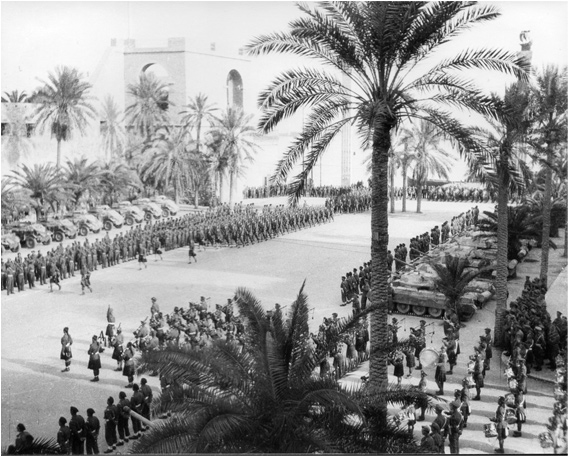127(HD) FIELD REGIMENT RA 1942 - 1945
from the Nile to the Weser
This short account has been provided by Ms Mary Duffus. It was given to her father in the Battery Office on disbandment at the end of the war. He served with the 51st Highland Division, 301/127 (H) Fld Regt RA, as a fitter seeing service at El Alamein, Sicily, Normandy and right through to Bremerhaven. After the war he rejoined the TA and was commissioned in the REME.
A TALE OF TWO RIVERS
FROM THE NILE TO THE WESER
In eight countries, and four major campaigns, in conditions which varied between 120 degrees in the shade, and 40 degrees of frost, 127 (Highland) Field Regiment, which disbanded on 1st April 1946, fired over 650,000 shells at the enemy.
With the rest of the reconstituted Highland Division, this Regiment started its fighting career on the night of 23rd October 1942, with the 500 gun barrage of El Alamein. From then until VE day, it supported 153 Highland Brigade, whose battalions were the 1st and 5/7th Gordon Highlanders and the 5th Black Watch.

7th Black Watch - Victory Parade, Tripoli
show infoDescription:
Victory parade by 7th Black Watch after Tripoli was captured on the morning of 23rd january 1943.
Copyright:
Black Watch Museum
Tags:
The story of the 8th Army is now well known, and it was during the days of the long chase westwards to Tripoli and Tunis that the gunners of 127 learned the ways of living and the language of the "blue" which never left them -- the blackened brewcan, the Benghazi cooker, and the apparently limitless ways of serving bully beef will live longer in their minds than speeches and campaign ribbons. Four guns of 491 Battery were the first 8th Army guns into Tripoli, rolling into the deserted streets well before daybreak. To get them there, every other vehicle in the Battery had to be drained of petrol, so scarce were supplies at that stage.
After a short rest and a share in the Tripoli victory parade, the Regiment moved into desolate Tunisia, fought for the Mareth Line and Gabes, and the guns. entered Sfax with the leading- troops to the strains of “Cock o’ the North" - played by 51st Division pipers in dress kilts.
The African campaign was ended by a short spell of hard fighting in the craggy hills around Enfidaville.
June 1943 was spent resting and refitting in the pleasant little port of Bougie in Algeria, five hundred miles from the final gun position, but preparations were already under way for the invasion of Sicily, and after a rough crossing, the first elements of the Regiment landed early on D-day on the rocky southern coast of the island.
Thirty-eight days of hard fighting followed. Malaria was widespread, but the orchards and vineyards round Mount Etna were a pleasant change after the wastes of North Africa. On Sferro Plain where the Division fought for many days, a plain stone monument now stands in memory of those who fell. Among them are the dead of 127.

Clearing Minefields Nr. Le Havre
show infoDescription:
Infantry moving forward. A Flail minefield clearer is seen in the background (1st LHB B Squadron). Assault team forming up for Phase II attack by 152 Infantry Brigade. Sgt Collins 10th September 1944
Copyright:
Imperial War Museum - BU 859
The battle for Sicily won, the guns moved into Messina under cover of darkness, and dug-in in the streets to support the landing on the toe of Italy. O.P. parties were also sent for the initial landing.
Its second campaign completed, the Regiment went home to Britain to train for another D-day, and spent six months In England, first at Beaconsfield, and later at Long Melford in Suffolk.
Landing with 153 Brigade on the night of D-day, 127 moved up the River Orne alongside 6th Airborne Division, and for six weary weeks pounded away at Caen, finally breaking through with the Canadians at Falaise. During this period there were heavy casualties, particularly among the O.P. parties.
Chasing across France, the Regiment crossed the Seine, returned after four years to St. Valery, and after taking part in the capture of Le Havre, supported the Canadians at Calais and Boulogne.
The winter - a hard one - was spent in a series of small but sharp battles in the mud and rain of Holland, and Christmas 1944 found the Regiment on the icebound roads leading to the Ardennes, where the guns once more helped to halt and reverse Rundstedt's drive on Antwerp. Here, soldiers who had experienced the heat of Africa and SiciIy, faced and beat the new enemies, frostbite and exposure.

Royal Artillery Battery
show infoDescription:
The 5.5 inch guns of 235 and 336 Medium Batteries Royal Artillery line up to fire in support of the Rhine Crossing. 27th March 1945.
Copyright:
IMW - B 15767
Tags:
Back into Holland, and on 8th February 1945 127's joined the thousand guns which opened the savage battles of the Reichswald, in which the Division had more casualties than during the whole of the Sicilian campaign. And on the night of 23rd March, O.P. parties from the Regiment were among the first troops to land on the East bank of the Rhine, while the three Batteries fired throughout the night, from positions 600 yards from the river, and under frequent enemy fire. Here, as at the Seine, their range was little over 1000 yards. The Rhine W3S crossed and the Ems. Bremen was by-passed, and finally on 6th May, a few miles from Bremerhaven, the order "Cease Firing" was given for the last time.
During its battle career, the Regiment has won 1 DSO, l OBE, 1 MBE, 11 MCs, 11MMs, 2 French Croix de Guerre, 1 Belgian Croix de Guerre, 1 Order of Leopold, and 26 Mentioned in Despatches.
It has been commanded by Lt.Col C.H.D.Springfield, Lt.Col.H.St.M.Perry, Lt.Col.G.H.Baker O.B.E. M.C., Lt.Col.M Bumett D.S.O, and finally Lt Col.RS.Burton M.C.
